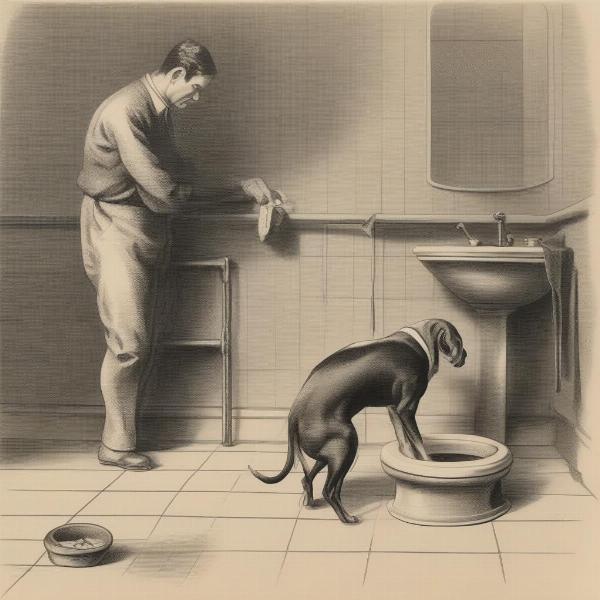Miralax for dogs is a common search term for pet owners concerned about their furry friend’s bowel movements. Constipation in dogs can be uncomfortable and even dangerous if left untreated. Miralax, generically known as polyethylene glycol 3350 (PEG 3350), is an osmotic laxative often used in humans and is sometimes recommended by veterinarians for canine constipation. This article delves into the uses, dosage, safety, and potential side effects of Miralax for dogs.
Is Miralax safe for dogs? What is the correct dosage? When should you consult a vet? We’ll answer these questions and more, providing you with a comprehensive guide to using Miralax for canine constipation. Understanding the proper use of this laxative can help alleviate your dog’s discomfort and ensure their digestive health.
Understanding Canine Constipation
Recognizing constipation in your dog is crucial for timely intervention. Common signs include straining during bowel movements, producing hard, dry stools, or having infrequent bowel movements. Several factors can contribute to constipation, including dietary issues, dehydration, lack of exercise, certain medications, and underlying medical conditions.
 Dog Constipation Symptoms
Dog Constipation Symptoms
Miralax for Dogs: How Does it Work?
Miralax works by drawing water into the colon, softening the stool and making it easier to pass. It’s an osmotic laxative, meaning it doesn’t stimulate the intestines directly. This can be beneficial for dogs as it generally causes less cramping and discomfort compared to stimulant laxatives.
Miralax Dosage for Dogs
The appropriate dosage of Miralax for dogs should always be determined by a veterinarian. They will consider your dog’s size, age, overall health, and the severity of the constipation. miralax for dog Giving too much Miralax can lead to diarrhea and dehydration, while too little may be ineffective.
Administering Miralax to Your Dog
Miralax is a tasteless, odorless powder that can be easily mixed with your dog’s food or water. Some dogs might be picky eaters and refuse food containing Miralax. In such cases, you can try dissolving the powder in a small amount of warm water and administering it using a syringe for dogs. Always ensure your dog has access to plenty of fresh water to prevent dehydration.
When to Consult a Veterinarian
While Miralax can be helpful for occasional constipation, it’s essential to consult a veterinarian if your dog’s constipation is persistent, severe, or accompanied by other symptoms like vomiting, lethargy, or loss of appetite. These could indicate a more serious underlying medical issue. dosage of miralax for dogs Never self-treat chronic constipation.
“It’s crucial to identify and address the underlying cause of constipation,” says Dr. Emily Carter, DVM. “While Miralax can offer temporary relief, it’s not a long-term solution for chronic digestive issues.”
Potential Side Effects of Miralax in Dogs
While generally safe, Miralax can cause side effects in some dogs. These may include diarrhea, vomiting, gas, and abdominal discomfort. miralax for dogs dosage If you observe any of these side effects, discontinue use and consult your veterinarian immediately. “Always start with the lowest recommended dose and monitor your dog closely,” advises Dr. David Miller, DVM. “This can help minimize the risk of side effects and ensure the medication’s effectiveness.”
Preventing Constipation in Dogs
A proactive approach to your dog’s diet and lifestyle can help prevent constipation. Ensure your dog has access to plenty of fresh water, a balanced diet rich in fiber, and regular exercise. miralax dog dosage Adding canned pumpkin or other fiber-rich foods to their diet can also help regulate bowel movements.
Conclusion
Miralax can be a helpful tool in managing occasional constipation in dogs. However, it’s crucial to consult with your veterinarian before administering Miralax to your dog, as they can determine the appropriate dosage and rule out any underlying medical conditions. Remember, providing your dog with a balanced diet, plenty of water, and regular exercise is key to promoting healthy digestion and preventing future bouts of constipation.
FAQ
- How long does it take for Miralax to work in dogs? Miralax typically starts working within 24-72 hours.
- Can I give my dog Miralax every day? No, Miralax should not be given daily unless specifically directed by your veterinarian. Long-term use can lead to dependence and electrolyte imbalances.
- What should I do if my dog has an adverse reaction to Miralax? Discontinue use immediately and contact your veterinarian.
- Are there any natural alternatives to Miralax for dogs? Adding fiber to your dog’s diet through foods like canned pumpkin or sweet potato can help regulate bowel movements.
- Is Miralax safe for puppies and senior dogs? Consult your veterinarian before administering Miralax to puppies or senior dogs, as they may require different dosages or have other health concerns.
- Can I use human Miralax for my dog? Yes, the same active ingredient is used in both human and veterinary formulations. However, always consult your vet for the correct dosage.
- What if my dog eats the entire container of Miralax? Contact your veterinarian or an emergency animal hospital immediately.
ILM Dog is a leading international online resource dedicated to providing expert advice and information on all aspects of dog care and wellbeing. From breed selection and puppy care to senior dog health and training, we offer comprehensive guides, practical tips, and up-to-date information to help you provide the best possible care for your canine companion. We specialize in breed selection guidance, health and medical care advice, training and behavioral insights, nutrition and feeding recommendations, grooming and hygiene tips, and product & accessory reviews. If you have any questions or need assistance, don’t hesitate to contact our team of experts at [email protected] or call us at +44 20-3965-8624. ILM Dog is your trusted partner in providing your dog with a happy, healthy, and fulfilling life.